The Kingston HyperX Fury RGB SSD Review: Bright Idea, Dimmed Performance
by Billy Tallis on September 24, 2018 8:35 AM ESTSequential Read Performance
Our first test of sequential read performance uses short bursts of 128MB, issued as 128kB operations with no queuing. The test averages performance across eight bursts for a total of 1GB of data transferred from a drive containing 16GB of data. Between each burst the drive is given enough idle time to keep the overall duty cycle at 20%.
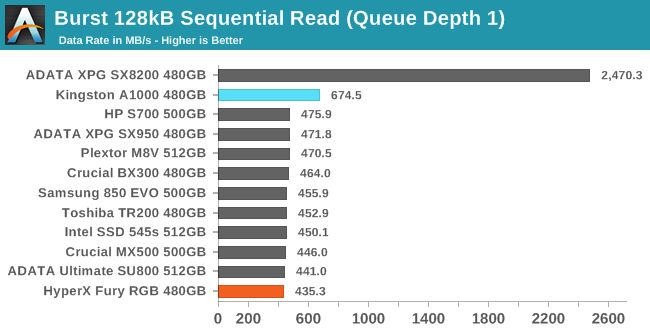
The QD1 burst sequential read performance of the HyperX Fury RGB is relatively slow for a SATA SSD, but it's less than a 10% difference relative to the fastest SATA drives in this batch.
Our test of sustained sequential reads uses queue depths from 1 to 32, with the performance and power scores computed as the average of QD1, QD2 and QD4. Each queue depth is tested for up to one minute or 32GB transferred, from a drive containing 64GB of data. This test is run twice: once with the drive prepared by sequentially writing the test data, and again after the random write test has mixed things up, causing fragmentation inside the SSD that isn't visible to the OS. These two scores represent the two extremes of how the drive would perform under real-world usage, where wear leveling and modifications to some existing data will create some internal fragmentation that degrades performance, but usually not to the extent shown here.
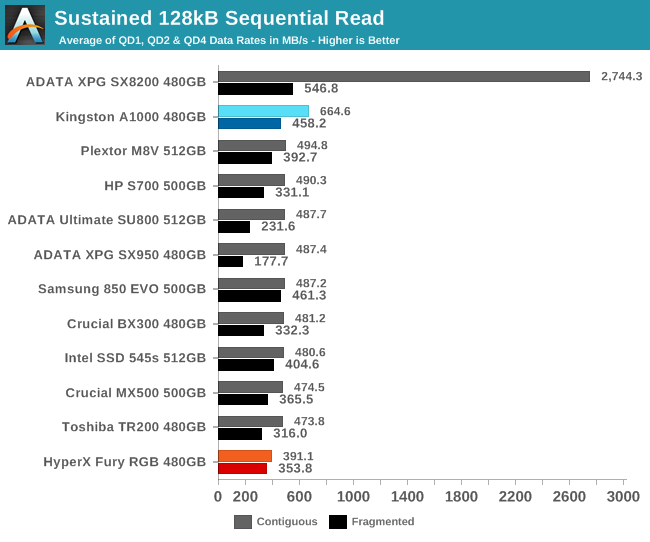
On the longer sequential read test the Fury RGB again comes in last place with substantially slower read speeds for contiguous data than any other drive in this batch, but it does handle internal fragmentation reasonably well.
 |
|||||||||
| Power Efficiency in MB/s/W | Average Power in W | ||||||||
Not counting the power used for the LED lighting, the Fury RGB uses a fairly normal ~2W for the sequential read test but it doesn't score very well on the efficiency rating because of the poor performance.
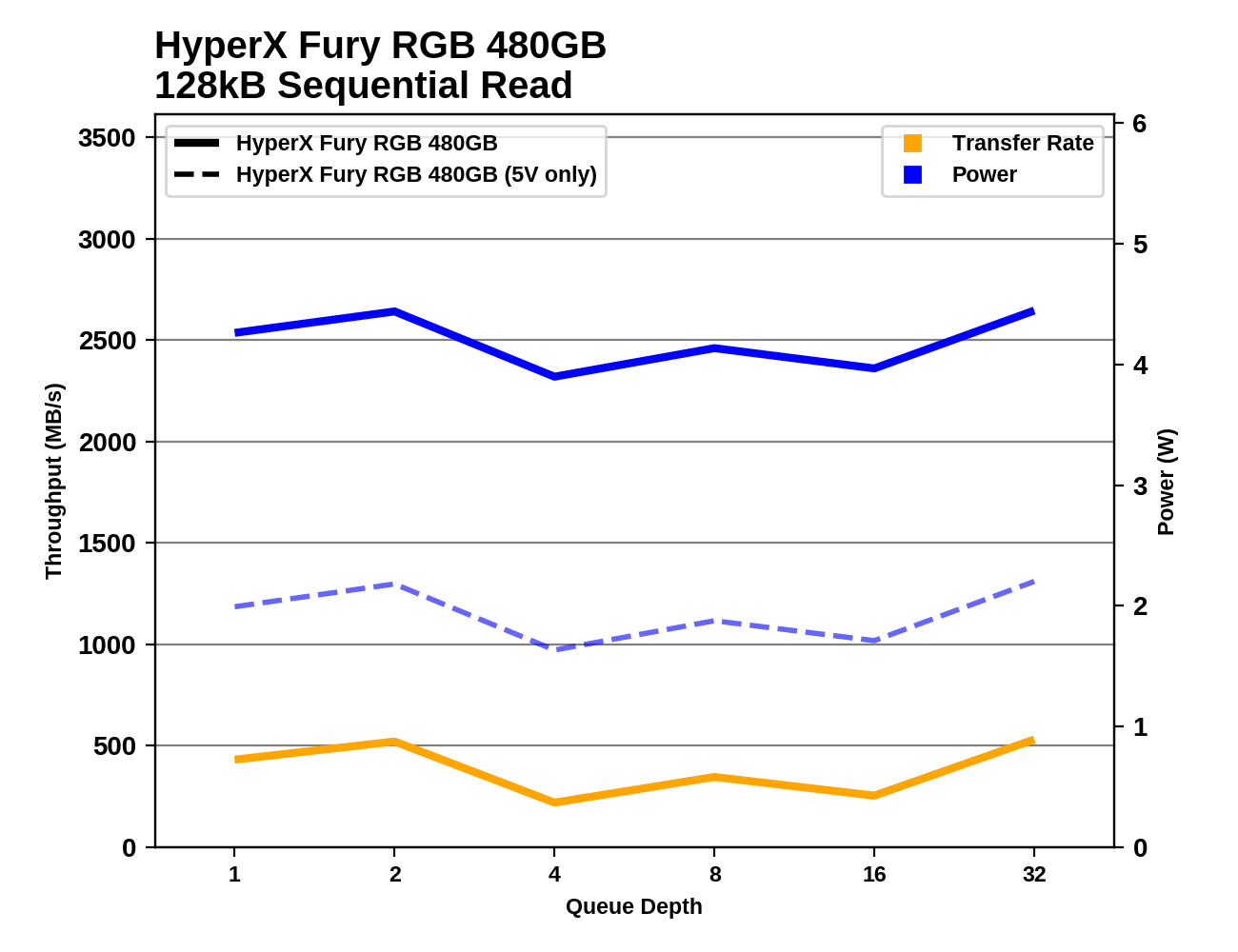 |
|||||||||
Performance on the sequential read test is unusually variable for the HyperX Fury RGB. Given that it is averaging over 4W for most of this test, I suspect we're seeing thermal throttling. SSDs without LED lighting idle at no more than 1W between phases of this test but the Fury RGB idles at over 3W under these conditions, largely defeating the purpose of the cooldown period between each phase.
Sequential Write Performance
Our test of sequential write burst performance is structured identically to the sequential read burst performance test save for the direction of the data transfer. Each burst writes 128MB as 128kB operations issued at QD1, for a total of 1GB of data written to a drive containing 16GB of data.
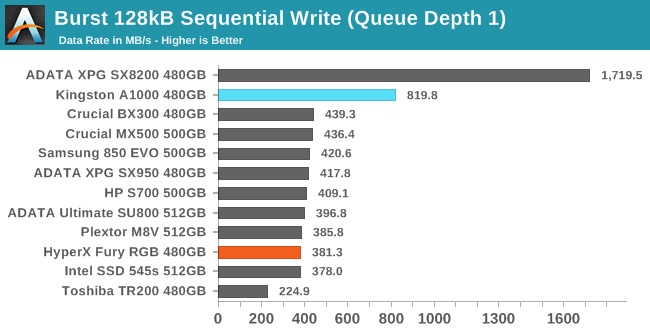
The HyperX Fury RGB SSD is slower than most SATA SSDs on the burst sequential write test but the 13% deficit relative to the fastest SATA drives is not a major problem.
Our test of sustained sequential writes is structured identically to our sustained sequential read test, save for the direction of the data transfers. Queue depths range from 1 to 32 and each queue depth is tested for up to one minute or 32GB, followed by up to one minute of idle time for the drive to cool off and perform garbage collection. The test is confined to a 64GB span of the drive.
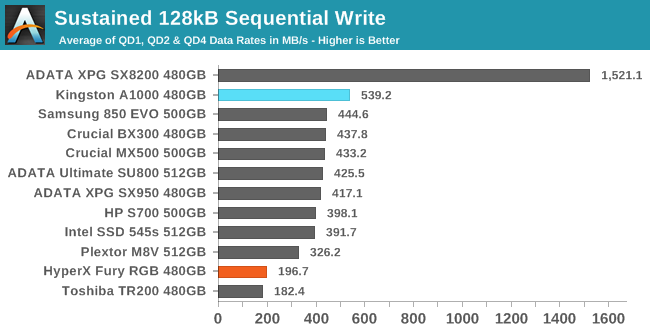
On the longer sequential write test, the Fury RGB has serious trouble: it slows down almost to the level of the DRAMless Toshiba TR200 and is averaging less than half the performance provided by most mainstream SATA SSDs.
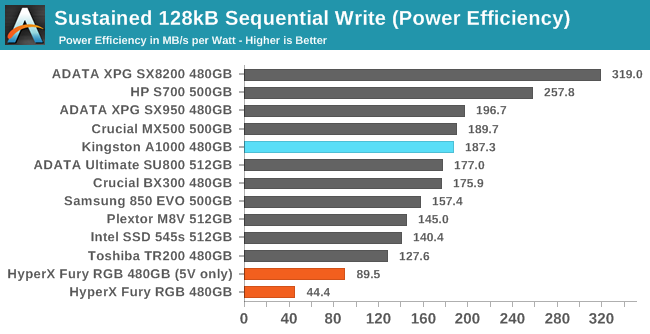 |
|||||||||
| Power Efficiency in MB/s/W | Average Power in W | ||||||||
The power used by the SSD side of the Fury RGB during the sequential write test is reasonably low, but since the performance is just plain bad, the efficiency rating is in last place by a wide margin even without counting the power used by the LEDs.
 |
|||||||||
The sequential write speed of the Fury RGB is at least consistent throughout the test, but it's performing like an entry-level SATA SSD. It isn't clear whether the drive is more limited by thermals or by a SLC write cache that fills almost immediately.










45 Comments
View All Comments
PeachNCream - Monday, September 24, 2018 - link
Form over function. All show and no go. - Those are the first things that pop into my mind after seeing the bottom drawer performance and high power consumption. We now have reached the point where there's a component that burns more electrical energy feeding pointless LEDs than it does actually fulfilling its duties as a component in a computer. Here's to enthusiasts and gamers! Good going people. You've really made the world a better place by making LEDs on everything marketable.rrinker - Monday, September 24, 2018 - link
Most make me an old fogey, but I totally agree. I'm not sure why any gamer or enthusiast would even buy this thing, do the flashing lights actually make up for the reduced performance - considering it's supposedly 'performance' these people are after. Perhaps this may be the jump the shark moment for RGB on everything - it's now gone so far that is actually affects the performance of the peripheral the lights are supposed to be 'enhancing'.melgross - Monday, September 24, 2018 - link
No, lighting is very important to a segment of that market. Lit DRAM, feet, strings of LEDs and neon inside, and out. Replacing the cover with a clear plastic one(violating the FCC protocols), is very important to them.Stupid cases such as the ones from Alienware, and others, show what these in the gaming community want. Not all of them are like that, but a big enough percentage are, and it’s a VERY big market. They get over 100,000 people to some of the ComicCons around the country.
rrinker - Monday, September 24, 2018 - link
The difference being, this one actually reduces performance. At least with most anything else up til now, it was just added cost and some increased power consumption, but the LEDs on the RAM don;t make the actual chips hotter, or the LEDs controllers on the mobo don't make the VR modules or chipset run hotter and throttle. I could probably run a lot of LEDs and still use less power than my system was when it had a GTX480, which I replaced with a GTX970. But that's just power draw, even if my system wasn't half buried in a stand under my printer next to my desk, gaudy case lighting wouldn't cause my CPU or GPU to throttle. This thing - this is just all-around fail. I guess this does not apply to the serious performance nut - the ones who swear they can tell the difference between 1MHz differences in clock speeds to the CPU or RAM, because they probably wouldn't be running SATA SSDs anyway, but this is just beyond insane, reducing performance and increasing cost for the sake of a bunch of flashing lights. I have a bridge to sell the people that go for this, too. Oh wait, I better add lots of LED lights to it first.melgross - Monday, September 24, 2018 - link
RAM runs hot as it is. Adding LEDs doesn’t help. Does it damage performance? I don’t know.qlum - Tuesday, September 25, 2018 - link
DDR4 doesn't run that hot and adding leds on the edge of the memory sticks doesn't impact the temperature of the ram much. Heat from the top of the sticks is pretty easy to dissipate. Besides that this sdd uses way too much leds and blocks most of their light.dromoxen - Tuesday, September 25, 2018 - link
The telling point is that you can use this without the data storage functionality (and excess cables) getting in the way of its true purpose, which is to light the way to the Promised LandTitanX - Tuesday, September 25, 2018 - link
indeed..i want not a single light on my PC except for the HDD activity and power indicator. no glass..no view panels..just an inconspicuous black box.MrSpadge - Monday, September 24, 2018 - link
At least the naming is adequate: it makes you hyper furious while waiting for your data and wondering about your electricity bill!TitanX - Tuesday, September 25, 2018 - link
dude..its 2 watts...dont think that makes more than a nickel a year on the ole bill..